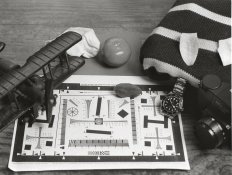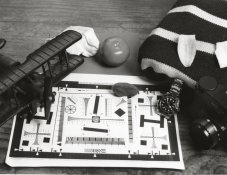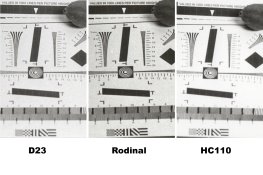sterioma
Member
Lately I have been playing reading a bit about D23 and decided to give it a go with dilution 1:1. This is the first time I make a developer from raw ingredients; I normally use Rodinal for slower films and HC-110 for higher speed films (mostly HP5).
I wanted to make a quick experiment comparing the three developers, with the only film I can bulk roll at the moment which is Fomapan 100. Let's go straight to the results and if you are still interested then read on.
Whole 8x10 prints (all printed identically with a condenser enlarger in my community darkroom).
D23:

Rodinal:

HC-110

Details comparison (around 2.5cm or 1 inch in the actual print):

As expected, Rodinal is the grainiest of the three but with this film and enlargement it's only really visible if you look carefully at the test resolution target. Second comes D23, while HC-110 has the finest grain.
D23 and HC110 give a moderate speed increase with respect to Rodinal, but it's probably not more than 1/3 stop in my test.
Rodinal gives by far the greatest impression of "sharpness", although probably there is not a big difference in terms of resultion but it's more acutance effects. In the small detailprint scan, the numbers and that checkerboard look really crisp with Rodinal, while they look blurry in the other two prints, especially with HC-110.
If you are curious here's my test setup (again, not very scientific, so take everything with a pinch of salt):
I wanted to make a quick experiment comparing the three developers, with the only film I can bulk roll at the moment which is Fomapan 100. Let's go straight to the results and if you are still interested then read on.
Whole 8x10 prints (all printed identically with a condenser enlarger in my community darkroom).
D23:

Rodinal:

HC-110

Details comparison (around 2.5cm or 1 inch in the actual print):

As expected, Rodinal is the grainiest of the three but with this film and enlargement it's only really visible if you look carefully at the test resolution target. Second comes D23, while HC-110 has the finest grain.
D23 and HC110 give a moderate speed increase with respect to Rodinal, but it's probably not more than 1/3 stop in my test.
Rodinal gives by far the greatest impression of "sharpness", although probably there is not a big difference in terms of resultion but it's more acutance effects. In the small detail
If you are curious here's my test setup (again, not very scientific, so take everything with a pinch of salt):
- Camera and lens: Yashica FX-D 35mm camera with 50mm 1.2 ML lens mounted on a tripod (camera is actually on sale if you are interested
 )
)
- Film: Fomapan 100 bulk rolled, exposed at 50 (this is my usual rating for Rodinal derived from previous testing)
- Metering: incident reading with a Sekonic 308
- Lighting: window light from the top on a overcast day + 1 softbox
- Subject matter: 24 identical frames of variuos objects including a gray card (underneath the tangerine) and a test target printed with my inkjet printer (!)
- Development: D23 1:1 for 10 minutes, Rodinal 1:50 for 10 minutes, HC-110 dil H for 11 minutes. All developed in tanks, 30s initial agitation, then 3 inversions every minute.
- Prints: 8x10 prints on Ilford Multigrade, all exposed for the same time based on the first one I tried (D23). Rodinal is slightly darker than the others. If I had more time in the darkroom I would have tried to have matching highlights
- Scanner: prints have been scanned at 600dpi with a cheap Epson printer/scanner. All prints have been scanned identically and no changes have been made other than cropping.
Last edited:





 the difference is a surprise to me, I never saw it that extreme, e.g. on the developer comparison if fotoimport.no. Gotta get my hands on some Rodinal!
the difference is a surprise to me, I never saw it that extreme, e.g. on the developer comparison if fotoimport.no. Gotta get my hands on some Rodinal!


